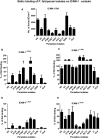An analysis of the binding characteristics of a panel of recently selected ICAM-1 binding Plasmodium falciparum patient isolates
- PMID: 25360558
- PMCID: PMC4216080
- DOI: 10.1371/journal.pone.0111518
An analysis of the binding characteristics of a panel of recently selected ICAM-1 binding Plasmodium falciparum patient isolates
Erratum in
-
Correction: An Analysis of the Binding Characteristics of a Panel of Recently Selected ICAM-1 Binding Plasmodium falciparum Patient Isolates.PLoS One. 2016 Feb 5;11(2):e0148836. doi: 10.1371/journal.pone.0148836. eCollection 2016. PLoS One. 2016. PMID: 26849362 Free PMC article. No abstract available.
Abstract
The basis of severe malaria pathogenesis in part includes sequestration of Plasmodium falciparum-infected erythrocytes (IE) from the peripheral circulation. This phenomenon is mediated by the interaction between several endothelial receptors and one of the main parasite-derived variant antigens (PfEMP1) expressed on the surface of the infected erythrocyte membrane. One of the commonly used host receptors is ICAM-1, and it has been suggested that ICAM-1 has a role in cerebral malaria pathology, although the evidence to support this is not conclusive. The current study examined the cytoadherence patterns of lab-adapted patient isolates after selecting on ICAM-1. We investigated the binding phenotypes using variant ICAM-1 proteins including ICAM-1Ref, ICAM-1Kilifi, ICAM-1S22/A, ICAM-1L42/A and ICAM-1L44/A using static assays. The study also examined ICAM-1 blocking by four anti-ICAM-1 monoclonal antibodies (mAb) under static conditions. We also characterised the binding phenotypes using Human Dermal Microvascular Endothelial Cells (HDMEC) under flow conditions. The results show that different isolates have variant-specific binding phenotypes under both static and flow conditions, extending our previous observations that this variation might be due to variable contact residues on ICAM-1 being used by different parasite PfEMP1 variants.
Conflict of interest statement
Figures



Similar articles
-
In vitro inhibition and reversal of Plasmodium falciparum cytoadherence to endothelium by monoclonal antibodies to ICAM-1 and CD36.Malar J. 2017 Jul 5;16(1):279. doi: 10.1186/s12936-017-1930-9. Malar J. 2017. PMID: 28679447 Free PMC article.
-
Interaction between Endothelial Protein C Receptor and Intercellular Adhesion Molecule 1 to Mediate Binding of Plasmodium falciparum-Infected Erythrocytes to Endothelial Cells.mBio. 2016 Jul 12;7(4):e00615-16. doi: 10.1128/mBio.00615-16. mBio. 2016. PMID: 27406562 Free PMC article.
-
PfEMP1 A-Type ICAM-1-Binding Domains Are Not Associated with Cerebral Malaria in Beninese Children.mBio. 2020 Nov 17;11(6):e02103-20. doi: 10.1128/mBio.02103-20. mBio. 2020. PMID: 33203751 Free PMC article.
-
The role of ICAM-1 in Plasmodium falciparum cytoadherence.Eur J Cell Biol. 2005 Jan;84(1):15-27. doi: 10.1016/j.ejcb.2004.09.002. Eur J Cell Biol. 2005. PMID: 15724813 Review.
-
Malaria's deadly grip: cytoadhesion of Plasmodium falciparum-infected erythrocytes.Cell Microbiol. 2013 Dec;15(12):1976-83. doi: 10.1111/cmi.12183. Epub 2013 Sep 4. Cell Microbiol. 2013. PMID: 23957661 Free PMC article. Review.
Cited by
-
ICAM-1 Kilifi variant is not associated with cerebral and severe malaria pathogenesis in Beninese children.Malar J. 2022 Apr 4;21(1):115. doi: 10.1186/s12936-022-04139-0. Malar J. 2022. PMID: 35379236 Free PMC article.
-
Developing a xenograft model of human vasculature in the mouse ear pinna.Sci Rep. 2020 Feb 6;10(1):2058. doi: 10.1038/s41598-020-58650-y. Sci Rep. 2020. PMID: 32029768 Free PMC article.
-
Enhanced Antimalarial and Antisequestration Activity of Methoxybenzenesulfonate-Modified Biopolymers and Nanoparticles for Tackling Severe Malaria.ACS Infect Dis. 2024 Feb 9;10(2):732-745. doi: 10.1021/acsinfecdis.3c00564. Epub 2024 Jan 25. ACS Infect Dis. 2024. PMID: 38271991 Free PMC article.
-
A semi-synthetic glycosaminoglycan analogue inhibits and reverses Plasmodium falciparum cytoadherence.PLoS One. 2017 Oct 18;12(10):e0186276. doi: 10.1371/journal.pone.0186276. eCollection 2017. PLoS One. 2017. PMID: 29045442 Free PMC article.
-
Safety, infectivity and immunogenicity of a genetically attenuated blood-stage malaria vaccine.BMC Med. 2021 Nov 22;19(1):293. doi: 10.1186/s12916-021-02150-x. BMC Med. 2021. PMID: 34802442 Free PMC article. Clinical Trial.
References
-
- WHO (2013) The World Malaria Report. Geneva: World Health Organization.
-
- Miller LH, Baruch DI, Marsh K, Doumbo OK (2002) The pathogenic basis of malaria. Nature 415: 673–679. - PubMed
-
- Baruch DI, Pasloske BL, Singh HB, Bi X, Ma XC, et al. (1995) Cloning the P. falciparum gene encoding PfEMP1, a malarial variant antigen and adherence receptor on the surface of parasitized human erythrocytes. Cell 82: 77–87. - PubMed
Publication types
MeSH terms
Substances
Grants and funding
LinkOut - more resources
Full Text Sources
Other Literature Sources
Miscellaneous

